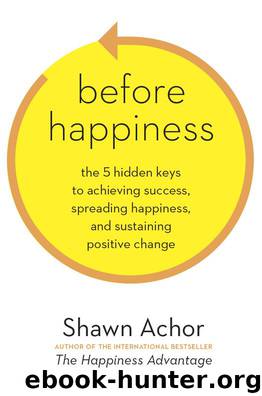Before Happiness by Shawn Achor

Author:Shawn Achor
Language: eng
Format: mobi, epub
ISBN: 9780770436742
Publisher: Crown Publishing Group
Published: 2013-09-09T21:00:00+00:00
STRATEGY 2: MAGNIFY THE TARGET SIZE (LIKELIHOOD OF SUCCESS)
The proximity of your goal isn’t the only thing that matters to your brain when it comes to constructing a reality. Just like those state-of-the-art Aegis missiles, your brain is constantly calculating the size of the target, or how likely you are to hit it. Here’s something that is important to understand about this skill: target size refers to the perceived likelihood of attaining a goal, not how big or important or how ambitious the goal is. Ironically, some of the biggest goals have the smallest target sizes. For example, becoming the CEO of Apple is a huge goal, but the target size is extremely small—realistically speaking, your chance of attaining it is slim to none. Think about darts. The larger the bull’s-eye, the more likely you are to hit it. Does that make hitting the bull’s-eye a great accomplishment? Not particularly (though I know some undergraduates who’d beg to differ). But it does make it more achievable.
The good news is that new research over the past five years shows that changing how you perceive the size of your target—that is, how you perceive the likelihood of succeeding—can have the same cognitive benefits as increasing your perceived proximity to it.
One of my favorite experiments on this particular success accelerator involves golf. In this study, participants were asked to putt from 1.7 meters away from the hole.9 Using a video projector, the researchers shone an image of a ring of either five large circles or eleven tiny circles around the hole, creating the famous Ebbinghaus illusion. In this diagram, which middle circle is bigger?
The answer of course is neither: they are the same size. In the Ebbinghaus illusion, a circle simply looks bigger if it is surrounded by smaller circles, and vice versa. So to recreate this illusion, the researchers surrounded a golf hole with large circles to see if the golfers would perceive it as smaller, even though they, of course, knew consciously that the hole was the same size. Then they looked at whether the golfers’ perception of the size of their target would affect their performance.
Download
This site does not store any files on its server. We only index and link to content provided by other sites. Please contact the content providers to delete copyright contents if any and email us, we'll remove relevant links or contents immediately.
| Ethics | Etiquette |
| Fashion & Image | Health & Stress |
| Motivation & Self-Improvement | Work Life Balance |
| Workplace Culture |
Tools of Titans by Timothy Ferriss(6974)
Change Your Questions, Change Your Life by Marilee Adams(6668)
Deep Work by Cal Newport(5514)
Man-made Catastrophes and Risk Information Concealment by Dmitry Chernov & Didier Sornette(4755)
Big Magic: Creative Living Beyond Fear by Elizabeth Gilbert(4741)
The Slight Edge by Jeff Olson(4732)
Digital Minimalism by Cal Newport;(4587)
The Motivation Myth by Jeff Haden(4542)
Stone's Rules by Roger Stone(4426)
Ego Is the Enemy by Ryan Holiday(4008)
The Laws of Human Nature by Robert Greene(3970)
Tuesdays with Morrie by Mitch Albom(3847)
Rising Strong by Brene Brown(3793)
Eat That Frog! by Brian Tracy(3532)
Skin in the Game by Nassim Nicholas Taleb(3488)
The Money Culture by Michael Lewis(3296)
Skin in the Game: Hidden Asymmetries in Daily Life by Nassim Nicholas Taleb(3278)
Believe It to Achieve It by Brian Tracy & Christina Stein(3221)
Bullshit Jobs by David Graeber(3194)
